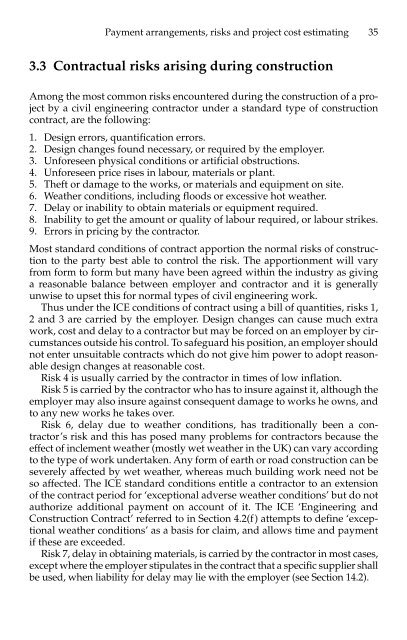Civil Engineering Project Management (4th Edition)
You also want an ePaper? Increase the reach of your titles
YUMPU automatically turns print PDFs into web optimized ePapers that Google loves.
Payment arrangements, risks and project cost estimating 35<br />
3.3 Contractual risks arising during construction<br />
Among the most common risks encountered during the construction of a project<br />
by a civil engineering contractor under a standard type of construction<br />
contract, are the following:<br />
1. Design errors, quantification errors.<br />
2. Design changes found necessary, or required by the employer.<br />
3. Unforeseen physical conditions or artificial obstructions.<br />
4. Unforeseen price rises in labour, materials or plant.<br />
5. Theft or damage to the works, or materials and equipment on site.<br />
6. Weather conditions, including floods or excessive hot weather.<br />
7. Delay or inability to obtain materials or equipment required.<br />
8. Inability to get the amount or quality of labour required, or labour strikes.<br />
9. Errors in pricing by the contractor.<br />
Most standard conditions of contract apportion the normal risks of construction<br />
to the party best able to control the risk. The apportionment will vary<br />
from form to form but many have been agreed within the industry as giving<br />
a reasonable balance between employer and contractor and it is generally<br />
unwise to upset this for normal types of civil engineering work.<br />
Thus under the ICE conditions of contract using a bill of quantities, risks 1,<br />
2 and 3 are carried by the employer. Design changes can cause much extra<br />
work, cost and delay to a contractor but may be forced on an employer by circumstances<br />
outside his control. To safeguard his position, an employer should<br />
not enter unsuitable contracts which do not give him power to adopt reasonable<br />
design changes at reasonable cost.<br />
Risk 4 is usually carried by the contractor in times of low inflation.<br />
Risk 5 is carried by the contractor who has to insure against it, although the<br />
employer may also insure against consequent damage to works he owns, and<br />
to any new works he takes over.<br />
Risk 6, delay due to weather conditions, has traditionally been a contractor’s<br />
risk and this has posed many problems for contractors because the<br />
effect of inclement weather (mostly wet weather in the UK) can vary according<br />
to the type of work undertaken. Any form of earth or road construction can be<br />
severely affected by wet weather, whereas much building work need not be<br />
so affected. The ICE standard conditions entitle a contractor to an extension<br />
of the contract period for ‘exceptional adverse weather conditions’ but do not<br />
authorize additional payment on account of it. The ICE ‘<strong>Engineering</strong> and<br />
Construction Contract’ referred to in Section 4.2(f) attempts to define ‘exceptional<br />
weather conditions’ as a basis for claim, and allows time and payment<br />
if these are exceeded.<br />
Risk 7, delay in obtaining materials, is carried by the contractor in most cases,<br />
except where the employer stipulates in the contract that a specific supplier shall<br />
be used, when liability for delay may lie with the employer (see Section 14.2).


















